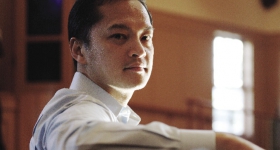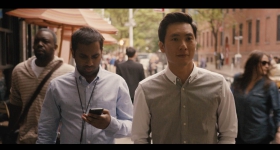[Content warning: the following article contains references to domestic violence and abuse. Readers can find a list of resources for survivors here]
In March, a hotline operator at Korean American Family Services (KFAM) received a call from a domestic violence survivor in crisis. A Korean immigrant had left her abuser but remained unsafe in her new home. Her landlord had been harassing her since the pandemic started, but now he was threatening to evict her in order to prevent coronavirus from spreading in the building. It didn’t matter that she was healthy; her ethnicity alone marked her as a contagion.
Across the country, domestic violence organizations that cater to Asian American and Pacific Islander (AAPI) survivors are experiencing a surge in hotline calls and an unprecedented demand for support services. According to Executive Director Jeehae Fischer, for example, the Korean American Family Service Center (KAFSC) witnessed a 300% increase in call volume between March and May 2020 and continues to see twice the volume of calls they saw this time last year. While all women in abusive relationships face elevated risks of violence during the pandemic, the rise in anti-Asian racism and xenophobia has created specific challenges for AAPI survivors and the organizations that serve them.
Even before the pandemic, AAPI survivors were less likely to report abuse and access mental health services than women of other races. Coronavirus-fueled racism compounds the alienation and invisibility of AAPI survivors, undermining their ability to escape and recover from familial violence.
“The amount of fear and isolation that someone feels in an abusive relationship is beyond anyone’s imagination and then to have to experience the additional fear of racism when you step outside of the home,” says Niketa Sheth, the former executive director of Womankind. “You’re not quite safe anywhere. You are not safe at home [and] you are not safe outside of the home.”
Discrimination Increases Isolation
Research has found that perceived discrimination simultaneously increases the risk for domestic violence and decreases help-seeking behavior. For AAPI survivors, particularly those who are disenfranchised or underserved, the rise in harassment and hate crimes targeting Asian Americans reinforces anxieties that dissuade survivors from reporting abuse, such as the mistrust of law enforcement or fear of receiving backlash from their community, and isolates them further.
“Some of our clients have experienced anti-Asian sentiment directly from NYPD. It’s just, this is a time where people are not going to necessarily call mainstream resources because there is [this] heightened fear already,” says Sheth.
Survivors may also be afraid that reporting incidents of abuse will contribute to the public’s anti-Asian sentiment. As a result, some women may prefer to suffer in silence rather than risk fueling social stigma against their families and communities.
The current anti-Asian sentiment also makes it more difficult for women to leave their abusers. Concerns about being targeted outside of the home can shape an individual’s perception of their options and their willingness to leave a violent situation. Ultimately, many women feel safer staying with their abusers when the alternative could expose them not only to a deadly virus, but also a world that blames them for it.
In response, crisis line operators say that callers are more desperate and distressed. “Our calls normally do have some pain in them, but there is more angst and uncertainty from the callers than before,” says Nilda Guanzon Valmores, the Executive Director of My Sister’s House.
Racism Exacerbates Psychological Harm
Experiences of racism can negatively impact mental health and in turn, influence survivors’ ability to heal and cope with the trauma of domestic violence. For example, discrimination exacerbates the symptoms of PTSD, the prevalence of which is disproportionately high in survivors of intimate partner violence.
Indeed, in recent months, service providers have noticed an increase in cases and symptom severity of PTSD among Asian American survivors, the effects of which are likely to persist long after the virus itself is contained.
“Many of the survivors with PTSD were trying to be comfortable going to the grocery store before COVID-19. Now, the fear is so much higher,” says Orchid Pusey, the executive director of the Asian Women’s Shelter (AWS). “There is a lot of hesitancy and people want to stay back.”
According to Sheth, there has been a rise in indication for one-on-one counseling on PTSD, and survivors have reported that the pandemic has affected their mental health and created “heightened anxiety around going outside and not [being] sure where you would be safe.”
Fischer echoes this sentiment, stating that even as restrictions ease, many survivors remain extremely hesitant about leaving their homes: “We had a client who went to the post office and she was being yelled at by this woman and ever since then, every time when she has to go run her errands she always calls us first to get emotional support and make sure it is safe.”
Pandemic Creates New Methods of Abuse
Domestic violence comprises a range of ongoing oppressive and coercive behaviors aimed at exerting power and control over another person. Perpetrators use a range of tactics to terrorize their victims beyond physical and sexual abuse. The pandemic has intensified the dynamic of domestic violence by engendering new forms and expressions of abuse.
One caller to the AWS hotline reported that her husband threatened to throw her out of the house if she started coughing and leave her to die alone in the hospital. Another woman said that because she worked outside of the home, her in-laws were not allowing her to be in the same room as her son. Counselors have also heard stories of abusers withholding disinfectants and essential supplies, preventing their partners from leaving the house, and threatening to intentionally expose them to the virus.
“I think of COVID-19 as a giant toolbox that got handed to batterers,” says Pusey, explaining that perpetrators rely on multiple tactics and will use any tool that is available to them to exert power and control, including in this case, the rising anti-Asian sentiment. According to Pusey, abusers present the hostile racial climate as a barrier to social services, saying things like: “‘So you think you are going to an American shelter? Everybody is going to avoid you. Nobody is going to let you in. They aren’t letting Asians into shelters right now.’”
With all of the news reports about increased harassment towards Asian Americans, coupled with the xenophobic messaging and anti-immigration policies from the current administration, victims often have no reason not to believe their abusers are telling the truth.
New Factors Increase Risk of Violence
The pandemic has introduced new factors that could escalate tensions and increase the risk of violence, particularly in households prone to abuse. Advocates are particularly concerned about the surge in gun sales among first-time Asian American buyers — a notable trend given the population’s historically low rate of firearm ownership. The presence of guns in abusive households can increase the risk of domestic homicide for women by as much as 500 percent, which is all the more disturbing considering that Asian American women are at greater risk for domestic homicide.
“The increase in gun sales is terrible,” says Pusey. “If an abusive person becomes a gun owner, the domestic violence is worse automatically. He doesn’t even have to use it, it’s just the threat of him having it there.”
Financial insecurity and unemployment are also associated with higher incidents of intimate partner violence. Asian American workers and business owners have a disproportionately high presence in hard-hit industries, increasing their exposure to the economic devastation wrought by COVID-19. In New York — the epicenter of the COVID-19 outbreak — Asian American workers have had the highest percent increase in unemployment filings each week by significant margins.
Racial hostilities exacerbated the financial vulnerability of Asian-owned businesses by driving customers away from Chinatowns and Chinese restaurants beginning in January. Two months before the first stay-at-home order was issued, sales had already plummeted by as much as 80% at Asian American businesses across the country.
The economic downturn also makes it harder for people to escape abusive relationships, even if they’ve been preparing to do so for a while. For example, one woman was working with KAN-WIN to save money so that she could leave her abusive partner. Her hours were slashed in response to the coronavirus outbreak. “Now,” says Development Associate Yeonju Ahn, “she doesn’t believe that she can get divorced from him anymore. Like all of the progress that she has made, it is just at square one again.”
Accessibility Issues Expand Barriers to Service
The pandemic has magnified many of the barriers AAPI survivors face in obtaining equitable legal, economic and social resources. Many services and programs are now being offered virtually, creating accessibility issues for survivors who lack the technology or English language proficiency required to use them.
“One of the challenges is just being able to have the technology or computer to access some of the information, but I would also say that we can’t assume the internet is going to serve the communities we serve because of the translation issues,” says Sheth.
Language accessibility is a significant concern for Asian American survivors searching for support — a third of the population lacks English proficiency. While the government translates some of its forms and resources into commonly spoken languages such as Spanish and Chinese, significant gaps remain in the information available to non-English speakers. In the absence of adequate language resources from the government and national organizations, AAPI survivors rely heavily on community-based organizations to help navigate legal, health and social service systems.
The coronavirus outbreak has simultaneously increased the importance and complicated the process of providing effective and timely translation. The demand for interpretation is at an all-time high and nonprofits are scrambling to keep pace with the flood of information being released on a day-to-day basis. The process has also been further complicated by social distancing protocols. Advocates typically help survivors with legal paperwork and public benefits applications in person, but now, many are forced to provide assistance over the phone, making the process difficult and time consuming for the parties involved.
Service Providers Overworked and Underfunded
Many of the domestic violence organizations that provide specialized services for AAPI survivors were already operating at a subsistence level before the pandemic, due in large part to the chronic underinvestment in culturally-specific programming by all levels of government. Private foundations have contributed to this disparity by also underfunding minority-led nonprofits and initiatives designed for women of color.
Now, they’re being stretched even thinner by the increase in demand and grappling with financial hardships as a result of the pandemic. For example, nonprofits were forced to reallocate resources in order to shift their programming online and meet the immediate needs of survivors, which allowed them to continue providing essential services but placed many of them at long-term financial risk.
At the same time, revenue streams have dried up, forcing nonprofits to cut staff and services or close down altogether. Social distancing protocols disrupted government contracts and fundraising activities. Cities and states have also begun slashing their budgets and divesting in human services — at a time when they are needed the most. This presents a significant challenge for smaller, community-based organizations — particularly those who serve and are led-by historically disenfranchised groups — that lack a large donor network and often, the staff and bandwidth required to cultivate one.
“Organizations like us who cater to a niche population get overlooked, but when disasters like this happen, it’s these really vulnerable populations that get disproportionately impacted. Our counselors are working crazy hours trying to meet these needs,” says Ahn. “We have been allocating all of our time and resources into direct services and at this point, we don’t have the capacity to write all these compelling letters [to funders] and just don’t have the … brand recognition among the public to garner the kind of support we need to meet these surging demands.”
Historically marginalized communities and the organizations that serve them have borne the brunt of the pandemic’s economic and social impact. Yet, the current conversation and funding model for domestic violence obscures the particular inequities and isolation experienced by survivors who are not middle-class white women.
“I would love for people to put themselves in the shoes of an immigrant Asian survivor,” says Sheth. “The stories we’ve been hearing [are] that people are stuck at home more, so naturally there is going to be an increase in violence. But what does that mean for an Asian immigrant who has lost her income, is living in an abusive situation and doesn’t have one family member in the whole country?”










Comments